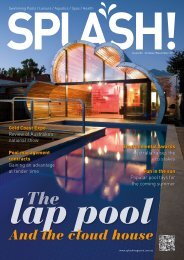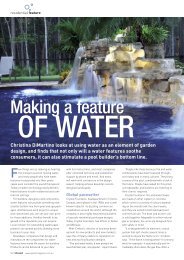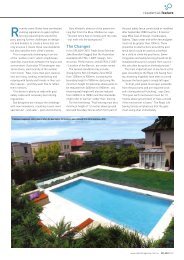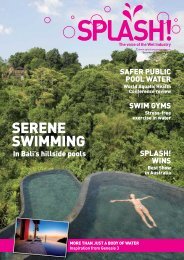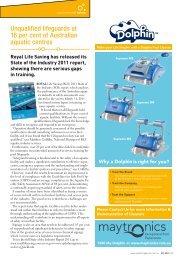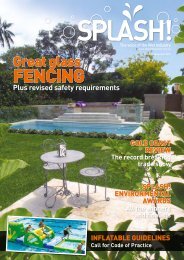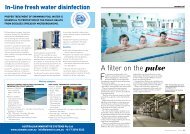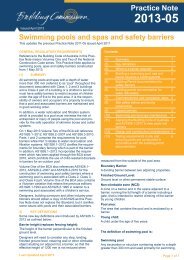Splash73p58-92 - Splash Magazine
Splash73p58-92 - Splash Magazine
Splash73p58-92 - Splash Magazine
You also want an ePaper? Increase the reach of your titles
YUMPU automatically turns print PDFs into web optimized ePapers that Google loves.
commercial feature<br />
and avoidance of swimming in contaminated<br />
water;<br />
n Ensuring adequate but effective disinfection<br />
in public pools liable to suffer diaper leakage<br />
or from diarrheal contamination;<br />
n Providing adequate bathroom breaks for<br />
children, adults and swim teams in training;<br />
n Mitigating the development of undesirable<br />
DBPs by reducing their precursors where<br />
known;<br />
n Encouraging better design of disinfection<br />
regimes and their management;<br />
n Promoting and conducting longitudinal<br />
studies on the effects of chloramines;<br />
THMs and N-Nitrosamines on swimmers<br />
– particularly in regard to asthma, and<br />
bladder and liver cancer.<br />
Of course, at a conference organised by the<br />
NSPF (which actively encourages and financially<br />
supports such research) these messages<br />
are very likely to resonate and eventually<br />
stand a good chance of implementation.<br />
The same cannot be said for Australia, where<br />
no serious effort is made to raise funds for<br />
research from the aquatics industry. This is<br />
despite the fact that the industry should be<br />
most interested in knowing how to relate to<br />
the evidence that DBPs are indeed a problem<br />
with potential liability implications.<br />
Cutting trihalomethane<br />
and chloramines<br />
Ole Gronborg, PhD, gave a seminar titled<br />
Reducing Trihalomethane and Chloramines<br />
in Swimming Pools.<br />
His credentials are comprehensive and<br />
impressive: an MSc in Environmental<br />
Engineering (Aalborg University, Denmark);<br />
full-time lecturer in Process and Waste Water<br />
Treatment in Aquaculture; Project Head<br />
Associate Professor Ole Gronborg PhD<br />
76 | SPLASH! www.splashmagazine.com.au<br />
in Innovation and New Water Treatment<br />
Technology, and Director of Skjolstrup and<br />
Gronborg Aps, Ultraaqua and more.<br />
His presentation differed from common<br />
and accepted ways of tackling various problems.<br />
Appropriately enough, his ideas have<br />
been supported by the Danish Government<br />
and applied now in five Danish public indoor<br />
pools. His systems reduce chlorine demand<br />
by 50 per cent, backwash water by 90 per<br />
cent (compared to sand filters) and energy<br />
consumption by 50 per cent.<br />
The Danes are justifiably considered<br />
one of the countries that have successfully<br />
invested money and resources into minimising<br />
waste of water, chemicals and energy.<br />
There is much to learn from them and from<br />
Gronborg in particular.<br />
Danish research has shown that human<br />
skin cells shed by swimmers range from<br />
10 micron to 30 micron. When caught in a<br />
sand filter they are reduced by the oxidants<br />
resulting in unwanted chlorinated DBPs.<br />
To minimise these, Gronborg has relied upon:<br />
n The Danes – like their German neighbours<br />
– insisting that every bather showers<br />
before entering a pool or spa, and this<br />
requirement is followed religiously by all<br />
swimming pool patrons;<br />
n A drum filter (manufactured in Sweden by<br />
Hydrotech) which backwashes a few times<br />
every hour for a few seconds only. This is<br />
done with sprays which wash the collected<br />
particles from the inside of the drum to<br />
waste. The drum filter has no media but its<br />
unique membrane (micro-screen) removes<br />
all particles down to 10 micron as do most<br />
good sand filters. This technology works by<br />
gravity only – there is no pressurised filter<br />
vessel. The filter therefore, ceases to be<br />
“encouraging healthier<br />
living though aquatic<br />
education and research<br />
in a global exchange<br />
of knowledge.”<br />
a “chloramine factory” – with the filtered<br />
water returning to the balance tank by<br />
gravitation minus 90 per cent of the skin<br />
cells and other undissolved solids;<br />
n The inorganic chloramines are then<br />
treated with medium density UV, while a<br />
side loop takes out any finer undissolved<br />
suspended solids (




